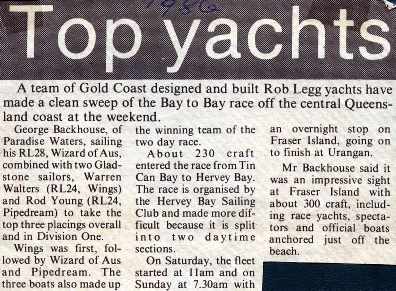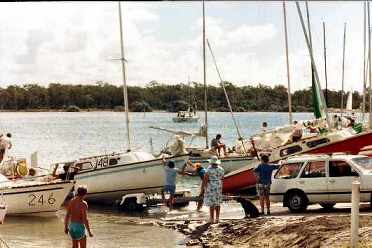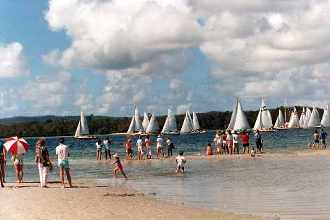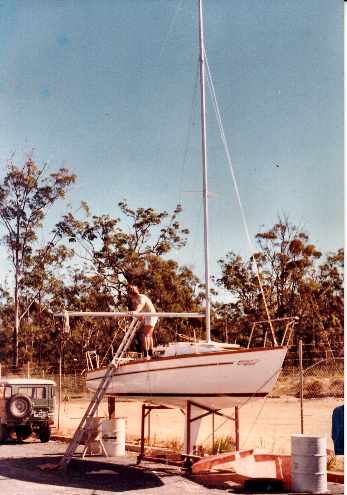
Barry Arnold set up
Elcondor to the JOG rule. The disadvantage of a fixed
keel is immediately obvious.
We now had the RL24 and the RL28 sailing in all states of Australia, and were fortunate to have some very talented owners
representing us in the important events around the country. George Backhouse with his 28 "Wizard of Aus" was performing
remarkably well, especially considering he had a diesel sail drive fitted.
In Queensland the most important event of the year was the two day "Bay to Bay race" and the results were more than pleasing.
With the RL24 and the RL28 in full production I could concentrate on the thirty-four footer that was on the drawing board.
I was convinced of the merits of the shoal draught concept for the Queensland coast, and wanted a boat that would be a
natural step up from the 28. Also there was a lot of interest from charter companies for a boat of minimal draught.
We had built a batch of the RL24s for Sydney with fixed keels and although they sailed well, I could not see any advantage
in a fixed keel boat of that size.
For the RL34 I wanted to have a very easily driven hull and a small rig, otherwise it would become too difficult for the
average family to handle, and a size up in gear and motor would add significantly to the cost. Besides that, it was never
meant to be raced. I seem to remember saying that once before!!!
We decided on conventional strip planking for the hull plug and intended to make use of it as a boat when the mould was
taken off. This would help defray the costs later.
To obtain sufficient ballast and to protect the bottom of the boat, I planned a stub keel, just big enough in area to
enable the boat to just sail to windward without the centreboard down, and the cast iron centreboard would fit within the
small case without intruding too much into the interior of the boat.
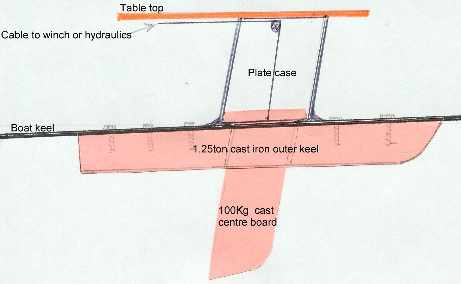
The Keel construction of the RL 34 is immensely strong, and the centre board when down
imparts no strain on the plate case.

The factory was full, so we had to build the plug for the 34 outside. At this stage the 18 mm thick strip
planked hull had been sheathed with fibre glass matt and cloth, then filled and sanded many times, and
finally sprayed with gelcoat.
Planning the accommodation was no problem as we had plenty of space to spare. In fact a small double cabin aft looked good
on paper and brought the cockpit more towards the centre of the boat. There was plenty of room to fit a diesel sail drive,
or conventional drive unit.
The rudder at first seemed a problem as the draught was too shallow for a conventional tube mounted rudder, and a drop-in
rudder blade would be too cumbersome to manhandle. The only alternative was to go back to a swing down blade with a sheer
pin. Steering with a wheel or tiller would be optional.
When the first boat was finished, we just had to try it out in the local downhill and offshore races, and surprisingly we
more than held our own with boats of around the same length, even though our rig was smaller.
We had entered in the annual "Southport to Ballina" 100 mile overnight race and finished with second fastest time against
a fleet of mostly racing boats, and that year we also won the downhill series.
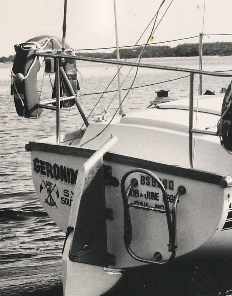
We used wheel steering, and had an
emergency slip on tiller.
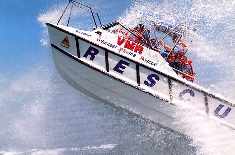
Air Sea Rescue (mostly supported by Apex) always did
a marvellous job, and deserved a lot more support from
the boating community.
Their call sign should always be
at the top of your radio or phone emergency list.
The old Southport Bar was always a problem. Twice we were forced to spend all night waiting for Air Sea Rescue to allow us
to cross after the entrance had been closed because of bad weather.
There was never any real channel, and the sandbar used to move around like a dog's tail. If it had been blowing from the
south the channel would move out to the north west, and after a northerly, the channel would move to the south, but there
was no real way of knowing exactly to where.
When ever there was a race, or when boats were waiting outside "Air Sea Rescue" would always come out if they could, and
lead the way in.
The trailer sailer market was booming and the concept was encouraging lots of young families to take up sailing. We had counted
over fifty different manufacturers within Australia. Two gentlemen by the name of Court from Western Australia arrived one day
requesting "a look over the factory", and some time later a TS arrived on the market under the name of Court. An owner of one
of our 24s lent his boat to a boat builder from Adelaide for the weekend, and guess what! Another TS model under his name came
on the market.
There was one manufacturer that I had a lot of respect for, and that was "Timpenny Yachts" of Sydney. Jon Simonds, one of the
principals of that firm, had covered the first "Tripolas" we had sailed in, as a writer for a boating magazine. He had gone to
report on the performance of the Timpennys, but instead had written about our boats performance.
We were to later build the "Status 580" Class boats for Jon.
It seems strange now, but one of the reasons that the boom in trailable yachts subsided was the advent of the "1983 Americas Cup".
